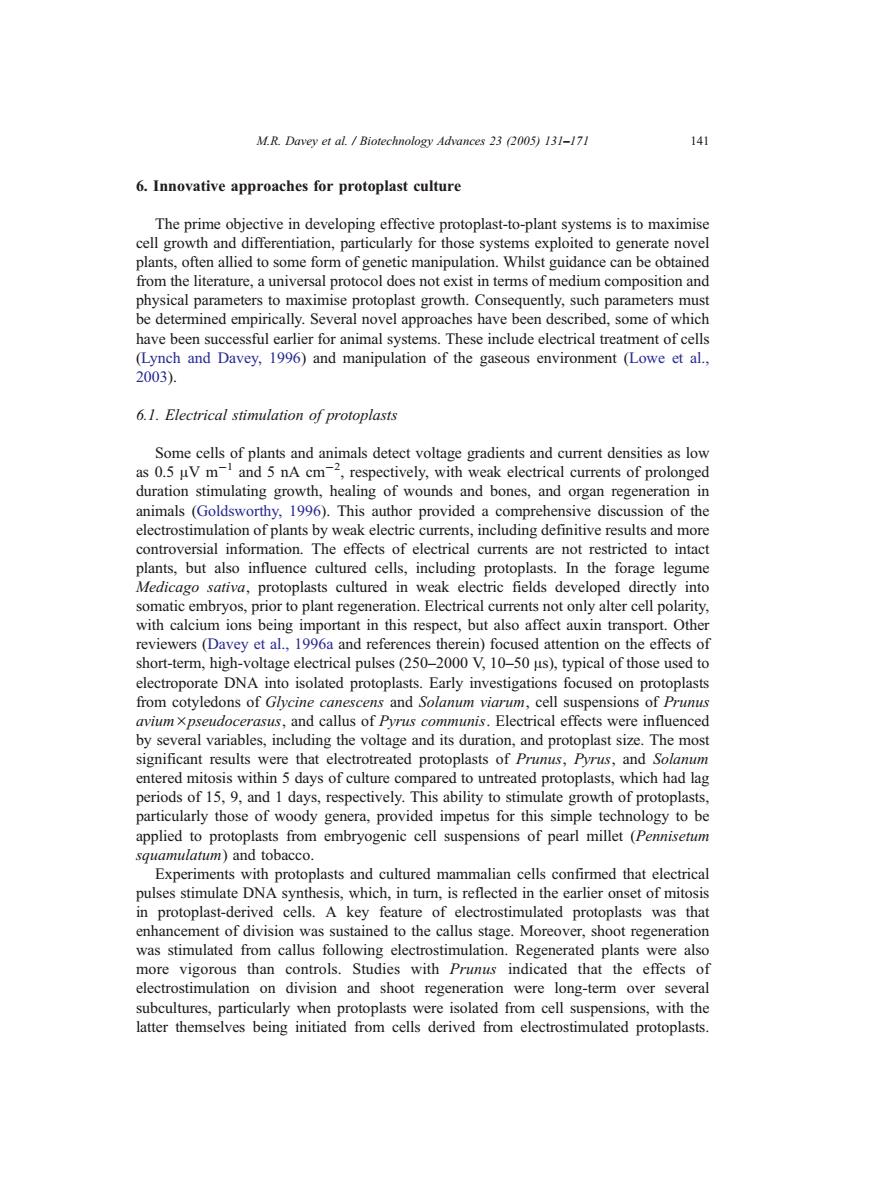正在加载图片...

M.R.Davey et al.Biotechnology Advances 23 (2005)131-171 141 6.Innovative approaches for protoplast culture The prime objective in developing effective protoplast-to-plant systems is to maximise cell growth and differentiation,particularly for those systems exploited to generate novel plants,often allied to some form of genetic manipulation.Whilst guidance can be obtained from the literature,a universal protocol does not exist in terms of medium composition and physical parameters to maximise protoplast growth.Consequently,such parameters must be determined empirically.Several novel approaches have been described,some of which have been successful earlier for animal systems.These include electrical treatment of cells (Lynch and Davey,1996)and manipulation of the gaseous environment (Lowe et al., 2003). 6.1.Electrical stimulation of protoplasts Some cells of plants and animals detect voltage gradients and current densities as low as 0.5 uV m-and 5 nA cm-2,respectively,with weak electrical currents of prolonged duration stimulating growth,healing of wounds and bones,and organ regeneration in animals (Goldsworthy,1996).This author provided a comprehensive discussion of the electrostimulation of plants by weak electric currents,including definitive results and more controversial information.The effects of electrical currents are not restricted to intact plants,but also influence cultured cells,including protoplasts.In the forage legume Medicago sativa,protoplasts cultured in weak electric fields developed directly into somatic embryos,prior to plant regeneration.Electrical currents not only alter cell polarity, with calcium ions being important in this respect,but also affect auxin transport.Other reviewers (Davey et al.,1996a and references therein)focused attention on the effects of short-term,high-voltage electrical pulses(250-2000 V,10-50 us),typical of those used to electroporate DNA into isolated protoplasts.Early investigations focused on protoplasts from cotyledons of Glycine canescens and Solanum viarum,cell suspensions of Prunus avium xpseudocerasus,and callus of Pyrus communis.Electrical effects were influenced by several variables,including the voltage and its duration,and protoplast size.The most significant results were that electrotreated protoplasts of Prunus,Pyrus,and Solanum entered mitosis within 5 days of culture compared to untreated protoplasts,which had lag periods of 15,9,and 1 days,respectively.This ability to stimulate growth of protoplasts, particularly those of woody genera,provided impetus for this simple technology to be applied to protoplasts from embryogenic cell suspensions of pearl millet (Pennisetum squamulatum)and tobacco. Experiments with protoplasts and cultured mammalian cells confirmed that electrical pulses stimulate DNA synthesis,which,in tum,is reflected in the earlier onset of mitosis in protoplast-derived cells.A key feature of electrostimulated protoplasts was that enhancement of division was sustained to the callus stage.Moreover,shoot regeneration was stimulated from callus following electrostimulation.Regenerated plants were also more vigorous than controls.Studies with Prunus indicated that the effects of electrostimulation on division and shoot regeneration were long-term over several subcultures,particularly when protoplasts were isolated from cell suspensions,with the latter themselves being initiated from cells derived from electrostimulated protoplasts.6. Innovative approaches for protoplast culture The prime objective in developing effective protoplast-to-plant systems is to maximise cell growth and differentiation, particularly for those systems exploited to generate novel plants, often allied to some form of genetic manipulation. Whilst guidance can be obtained from the literature, a universal protocol does not exist in terms of medium composition and physical parameters to maximise protoplast growth. Consequently, such parameters must be determined empirically. Several novel approaches have been described, some of which have been successful earlier for animal systems. These include electrical treatment of cells (Lynch and Davey, 1996) and manipulation of the gaseous environment (Lowe et al., 2003). 6.1. Electrical stimulation of protoplasts Some cells of plants and animals detect voltage gradients and current densities as low as 0.5 AV m1 and 5 nA cm2 , respectively, with weak electrical currents of prolonged duration stimulating growth, healing of wounds and bones, and organ regeneration in animals (Goldsworthy, 1996). This author provided a comprehensive discussion of the electrostimulation of plants by weak electric currents, including definitive results and more controversial information. The effects of electrical currents are not restricted to intact plants, but also influence cultured cells, including protoplasts. In the forage legume Medicago sativa, protoplasts cultured in weak electric fields developed directly into somatic embryos, prior to plant regeneration. Electrical currents not only alter cell polarity, with calcium ions being important in this respect, but also affect auxin transport. Other reviewers (Davey et al., 1996a and references therein) focused attention on the effects of short-term, high-voltage electrical pulses (250–2000 V, 10–50 As), typical of those used to electroporate DNA into isolated protoplasts. Early investigations focused on protoplasts from cotyledons of Glycine canescens and Solanum viarum, cell suspensions of Prunus aviumpseudocerasus, and callus of Pyrus communis. Electrical effects were influenced by several variables, including the voltage and its duration, and protoplast size. The most significant results were that electrotreated protoplasts of Prunus, Pyrus, and Solanum entered mitosis within 5 days of culture compared to untreated protoplasts, which had lag periods of 15, 9, and 1 days, respectively. This ability to stimulate growth of protoplasts, particularly those of woody genera, provided impetus for this simple technology to be applied to protoplasts from embryogenic cell suspensions of pearl millet (Pennisetum squamulatum) and tobacco. Experiments with protoplasts and cultured mammalian cells confirmed that electrical pulses stimulate DNA synthesis, which, in turn, is reflected in the earlier onset of mitosis in protoplast-derived cells. A key feature of electrostimulated protoplasts was that enhancement of division was sustained to the callus stage. Moreover, shoot regeneration was stimulated from callus following electrostimulation. Regenerated plants were also more vigorous than controls. Studies with Prunus indicated that the effects of electrostimulation on division and shoot regeneration were long-term over several subcultures, particularly when protoplasts were isolated from cell suspensions, with the latter themselves being initiated from cells derived from electrostimulated protoplasts. M.R. Davey et al. / Biotechnology Advances 23 (2005) 131–171 141��